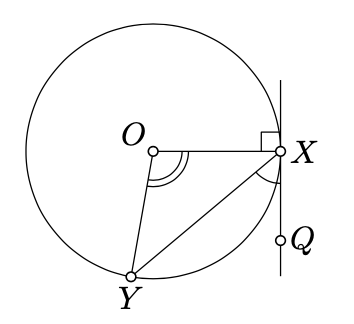9.1: Ángulo entre una línea tangente y una cuerda
- Page ID
- 114841
Dejar\(\Gamma\) ser un círculo con el centro\(O\). Supongamos que la línea\((XQ)\) es tangente a\(\Gamma\) at\(X\) y\([XY]\) es un acorde de\(\Gamma\). Entonces
\[2 \cdot \measuredangle QXY \equiv \measuredangle XOY.\]
Equivalentemente,
\(\measuredangle QXY \equiv \dfrac{1}{2} \cdot \measuredangle XOY\)o\(\measuredangle QXY \equiv \dfrac{1}{2} \cdot \measuredangle XOY + \pi.\)
- Prueba
-
Tenga en cuenta que\(\triangle XOY\) es isósceles. Por lo tanto,\(\measuredangle YXO = \measuredangle OYX\).
Aplicando el Teorema 7.4.1 a\(\triangle XOY\), obtenemos

\(\begin{array} {rcl} {\pi} & \equiv & {\measuredangle YXO + \measuredangle OYX + \measuredangle XOY \equiv} \\ {} & \equiv & {2 \cdot \measuredangle YXO + \measuredangle XOY.} \end{array}\)
Por Lemma 5.6.2,\((OX) \perp (XQ)\), Por lo tanto,
\(\measuredangle QXY + \measuredangle YXO \equiv \pm \dfrac{\pi}{2}.\)
Por lo tanto,
\(2 \cdot \measuredangle QXY \equiv \pi - 2 \cdot YXO \equiv \measuredangle XOY.\)


